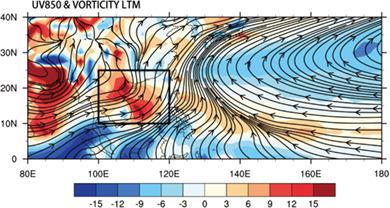当前位置:
X-MOL 学术
›
Int. J. Climatol.
›
论文详情
Our official English website, www.x-mol.net, welcomes your
feedback! (Note: you will need to create a separate account there.)
Interdecadal change in the relationship between interannual variation of the South China Sea monsoon trough and tropical Indo‐Pacific sea surface temperature
International Journal of Climatology ( IF 3.5 ) Pub Date : 2020-09-29 , DOI: 10.1002/joc.6853 Zeyu Zhang 1, 2 , Maoqiu Jian 1, 2 , Si Gao 1, 2 , Yunting Qiao 1, 2
International Journal of Climatology ( IF 3.5 ) Pub Date : 2020-09-29 , DOI: 10.1002/joc.6853 Zeyu Zhang 1, 2 , Maoqiu Jian 1, 2 , Si Gao 1, 2 , Yunting Qiao 1, 2
Affiliation

|
The South China Sea monsoon trough (SCSMT) presents remarkable year‐to‐year variability, which exerts great influences on the summer climate over the South China Sea and surrounding regions. The variation of SCSMT may be forced by the tropical Indo‐Pacific sea surface temperature anomalies (SSTAs). The relationship between interannual variability of the SCSMT and the SSTA in tropical Indo‐Pacific oceans experienced several interdecadal changes during 1958–2019, namely around the late 1970s, early 1990s, and mid‐2000s, respectively. In epoch 1 (1958–1977), the significant SSTA pattern associated with the weakening of the SCSMT features the warming in the eastern tropical Indian Ocean (TIO) and the Maritime Continent (MC) which contributes to interannual variation of the SCSMT via inducing anomalous local meridional circulation. In epoch 2 (1978–1992), there is strong warming in the whole Indian Ocean basin which induces southwest–northeast vertical circulation anomalies and excites warm Kelvin wave in tropospheric atmosphere, leading to the weakening of the SCSMT. The SSTA in epoch 3 (1993–2003) features significant warming in the eastern TIO and MC which influences the SCSMT via abnormal meridional circulation and Kelvin wave, and weak cooling in the central Pacific which partly contributes to the weakening of the SCSMT via Rossby wave response. The SSTA pattern in epoch 4 (2004–2014) is similar to that in epoch 3, while the warming in the MC is weaker with insignificant meridional circulation and Kelvin‐wave response, and the most significant feature is the cooling in the central to eastern Pacific (CEP) with strong Rossby wave response. These results suggest that, during different epochs, interannual variability of the SCSMT is modulated by SSTA in different key areas through different mechanisms, and the key area shifts eastward from the TIO to the CEP with time.
中文翻译:

南海季风槽年际变化与热带印度洋-太平洋海面温度关系的年代际变化
南海季风槽(SCSMT)呈现逐年变化,这对南海及周边地区的夏季气候影响很大。热带印度洋-太平洋海面温度异常(SSTA)可能会导致SCSMT的变化。热带印度洋-太平洋海洋中SCSMT和SSTA的年际变化之间的关系在1958-2019年间经历了几次年代际变化,即分别在1970年代末,1990年代初和2000年代中期。在第1个时期(1958年至1977年),与SCSMT减弱相关的重要SSTA模式表现为东部热带印度洋(TIO)和海洋大陆(MC)的变暖,这通过引起异常而导致SCSMT的年际变化局部经络循环。在第2阶段(1978-1992年),整个印度洋盆地都出现了强烈的变暖,这引起了西南向东北的垂直循环异常,并在对流层大气中激发了开尔文波,从而导致SCSMT减弱。第3季(1993-2003年)的SSTA的特征是东部TIO和MC发生了明显的变暖,这通过异常的子午环流和开尔文波影响了SCSMT,而中太平洋的降温则部分地导致了Rossby波对SCSMT的减弱。响应。第4阶段(2004-2014)的SSTA模式与第3阶段的模式相似,而MC的变暖减弱,子午环流和开尔文波响应不明显,最显着的特征是中东部的冷却太平洋(CEP)具有强Rossby波响应。这些结果表明,
更新日期:2020-09-29
中文翻译:

南海季风槽年际变化与热带印度洋-太平洋海面温度关系的年代际变化
南海季风槽(SCSMT)呈现逐年变化,这对南海及周边地区的夏季气候影响很大。热带印度洋-太平洋海面温度异常(SSTA)可能会导致SCSMT的变化。热带印度洋-太平洋海洋中SCSMT和SSTA的年际变化之间的关系在1958-2019年间经历了几次年代际变化,即分别在1970年代末,1990年代初和2000年代中期。在第1个时期(1958年至1977年),与SCSMT减弱相关的重要SSTA模式表现为东部热带印度洋(TIO)和海洋大陆(MC)的变暖,这通过引起异常而导致SCSMT的年际变化局部经络循环。在第2阶段(1978-1992年),整个印度洋盆地都出现了强烈的变暖,这引起了西南向东北的垂直循环异常,并在对流层大气中激发了开尔文波,从而导致SCSMT减弱。第3季(1993-2003年)的SSTA的特征是东部TIO和MC发生了明显的变暖,这通过异常的子午环流和开尔文波影响了SCSMT,而中太平洋的降温则部分地导致了Rossby波对SCSMT的减弱。响应。第4阶段(2004-2014)的SSTA模式与第3阶段的模式相似,而MC的变暖减弱,子午环流和开尔文波响应不明显,最显着的特征是中东部的冷却太平洋(CEP)具有强Rossby波响应。这些结果表明,











































 京公网安备 11010802027423号
京公网安备 11010802027423号